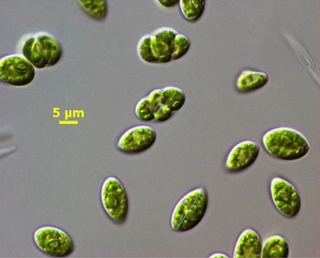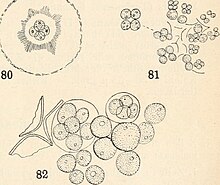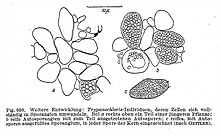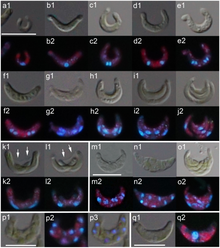
Asexual reproduction is a type of reproduction that does not involve the fusion of gametes or change in the number of chromosomes. The offspring that arise by asexual reproduction from either unicellular or multicellular organisms inherit the full set of genes of their single parent and thus the newly created individual is genetically and physically similar to the parent or an exact clone of the parent. Asexual reproduction is the primary form of reproduction for single-celled organisms such as archaea and bacteria. Many eukaryotic organisms including plants, animals, and fungi can also reproduce asexually. In vertebrates, the most common form of asexual reproduction is parthenogenesis, which is typically used as an alternative to sexual reproduction in times when reproductive opportunities are limited. Komodo dragons and some monitor lizards can reproduce asexually.

The Chlorophyceae are one of the classes of green algae, distinguished mainly on the basis of ultrastructural morphology. They are usually green due to the dominance of pigments chlorophyll a and chlorophyll b. The chloroplast may be discoid, plate-like, reticulate, cup-shaped, spiral- or ribbon-shaped in different species. Most of the members have one or more storage bodies called pyrenoids located in the chloroplast. Pyrenoids contain protein besides starch. Some green algae may store food in the form of oil droplets. They usually have a cell wall made up of an inner layer of cellulose and outer layer of pectose.
In botany, a zoid or zoïd is a reproductive cell that possesses one or more flagella, and is capable of independent movement. Zoid can refer to either an asexually reproductive spore or a sexually reproductive gamete. In sexually reproductive gametes, zoids can be either male or female depending on the species. For example, some brown alga (Phaeophyceae) reproduce by producing multi-flagellated male and female gametes that recombine to form the diploid sporangia. Zoids are primarily found in some protists, diatoms, green alga, brown alga, non-vascular plants, and a few vascular plants. The most common classification group that produces zoids is the heterokonts or stramenopiles. These include green alga, brown alga, oomycetes, and some protists. The term is generally not used to describe motile, flagellated sperm found in animals. Zoid is also commonly confused for zooid which is a single organism that is part of a colonial animal.

Characiochloridaceae is a family of green algae in the order Chlamydomonadales.
Atractomorpha is a genus in the Sphaeropleaceae, a family of green algae. The genus name is derived from Greek and means "spindle-shaped" or "arrow-shaped", and refers to the shape of the cells.

Bracteacoccus is a genus of green algae, the sole genus of the family Bracteacoccaceae. It is a terrestrial alga commonly found in soils, from the tropics to the poles.
Dictyochloropsis is a genus of unicellular green alga of the phylum Chlorophyta. This genus consists of free-living algae which have a reticulate (net-like) chloroplast that varies slightly in morphology between species, and that when mature always lacks a pyrenoid. Dictyochloropsis is asexual and reproduces using autospores.

Neochloris is a genus of green algae in the family Neochloridaceae. It is found in freshwater aquatic and terrestrial soil habitats.
Planktosphaeria is a genus of green algae, specifically of the Chlorophyceae. It was first described by the phycologist Gilbert Morgan Smith in 1918, with Planktosphaeria gelatinosa as its type species. Species of Planktosphaeria are commonly found in freshwater plankton around the world.
Pseudomuriella is a genus of green algae, specifically of the class Chlorophyceae. It is the sole genus of the family Pseudomuriellaceae. It is a terrestrial alga that inhabits soils.
Raphidocelis is a genus of green algae in the family Selenastraceae. They are found in freshwater habitats.

Selenastrum is a genus of green algae in the family Selenastraceae. It is common in freshwater habitats around the world. Most species prefer temperate or warm-temperate waters.

Tetraedron is a genus of green algae in the family Hydrodictyaceae. It may also be spelled as Tetraëdron.

Trebouxia is a unicellular green alga. It is a photosynthetic organism that can exist in almost all habitats found in polar, tropical, and temperate regions. It can either exist in a symbiotic relationship with fungi in the form of lichen or it can survive independently as a free-living organism alone or in colonies. Trebouxia is the most common photobiont in extant lichens. It is a primary producer of marine, freshwater and terrestrial ecosystems. It uses carotenoids and chlorophyll a and b to harvest energy from the sun and provide nutrients to various animals and insects.
Actinochloridaceae is a family of green algae, in the order Chlamydomonadales.
Chlorotetraedron is a genus of green algae, in the family Neochloridaceae. The name may also be written as Chlorotetraëdon. It is found as freshwater plankton or in soil.
Follicularia is a genus of green algae, in the family Schizochlamydaceae. It is found in terrestrial habitats, mainly soil.

Chlorokybus is a multicellular (sarcinoid) genus of basal green algae or charophyte. It has been classified as the sole member of the family Chlorokybaceae, which is the sole member of the order Chlorokybales, in turn the sole member of the class Chlorokybophyceae. It grows on soil and rock surfaces, and is rare.
Bracteamorpha is a genus of green algae in the order Sphaeropleales, and is the only genus in the family Bracteamorphaceae. It contains a single species, Bracteamorpha trainorii.
Asterochloris is a genus of green algae in the family Trebouxiophyceae. It is a common photobiont in lichen, occurring in the thalli of more than 20 lichen genera worldwide. Asterochloris is distinguishable from the morphologically similar genus Trebouxia, primarily due to its deeply lobed chloroplast, the placement of the chloroplast along the cell's periphery before the initiation of zoospore or aplanospore formation, and its tendency to primarily reproduce asexually through the production of aplanospores.











